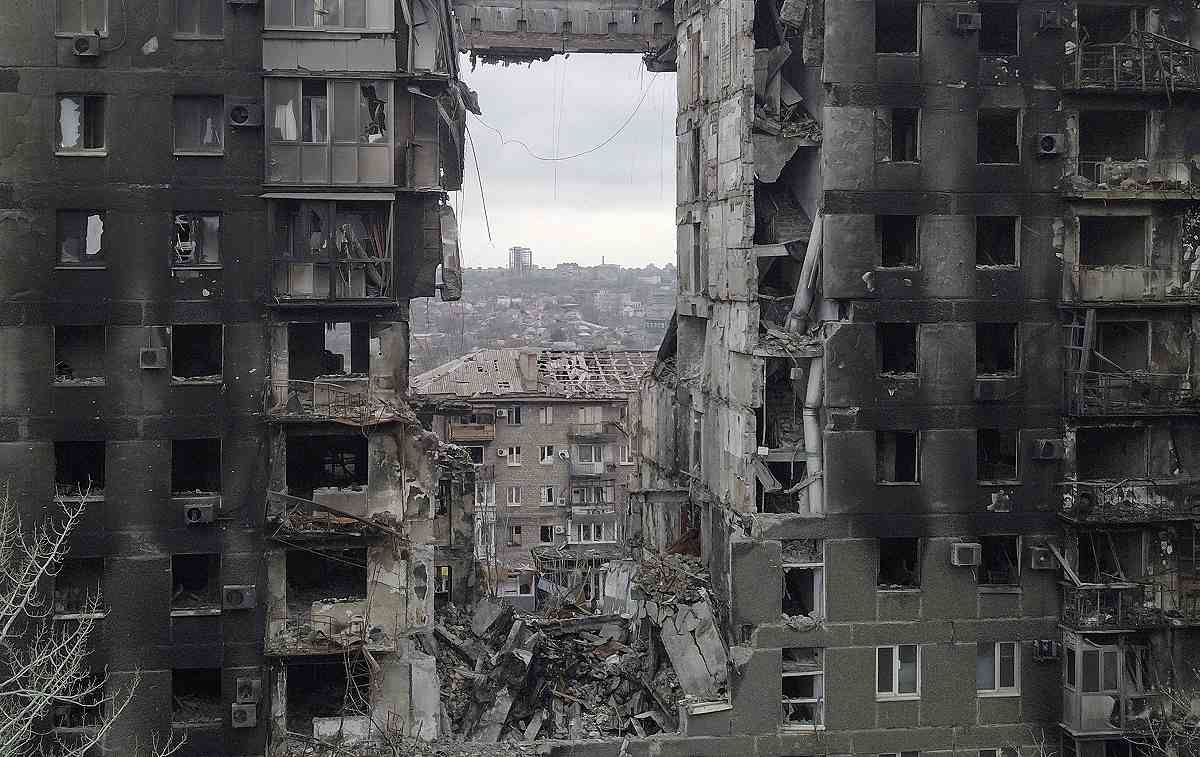
A destroyed residential building is seen in the course of the Ukraine-Russia conflict in the southern port city of Mariupol, Ukraine, on April 14, 2022.
16:25 JST, June 15, 2023
LONDON (Reuters) — The war in Ukraine is deepening the climate crisis at a time when global greenhouse gas emissions are already running at a record high, according to a report by carbon accounting experts who have tallied the overall impact of the conflict.
The report calculates that the first 12 months of the war will trigger a net increase of 120 million tons of greenhouse gases, equivalent to the annual output of a country such as Belgium.
A group of researchers led by Dutch expert Lennard de Klerk looked at a range of contributors to emissions, from fuel used by vehicles, to forest fires, to changes in energy use in Europe and the future reconstruction of buildings and infrastructure.
“We didn’t expect the emissions of war would be so significant and it’s not only the warfare itself that contributes to the emissions, but it’s also the future reconstruction of the destroyed infrastructure,” said de Klerk by phone from his home in Hungary near the border with Ukraine.
Carbon accounting will be in focus at the COP28 climate summit in Dubai this year as countries assess progress against climate goals agreed in Paris in 2015, and de Klerk said it was crucial military emissions were included.
“Emissions of conflicts and military emissions are often overlooked,” he told Reuters.
“The aim that we all should have is to get to net zero by 2050, including the military, but if you don’t know what the military emissions are, it’s very difficult to start work on policies to reduce them,” de Klerk said.
The report — Climate Damage Caused By Russia’s War in Ukraine — was funded by the European Climate Foundation and the Environmental Policy and Advocacy Initiative in Ukraine.
Gas leaks, bombs
According to the report, seen by Reuters, almost half of the net increase in emissions since the Ukraine war started in February last year are linked to the anticipated reconstruction of buildings, roads and factories damaged in the fighting.
About 19% of the emissions, meanwhile, come from military activities such as burning fuel in vehicles, making and firing ammunition and the construction of concrete fortifications.
The overall tally included greenhouse gas emissions from outside Ukraine linked to the conflict, such as gas leaks from the sabotaged Nord Stream pipeline, the rerouting of international flights, as well as the movement of refugees.
“If you look at the environmental costs of what’s happening in Ukraine, that war is a catastrophe when it comes to carbon emissions,” said James Appathurai, NATO’s deputy assistant secretary general for emerging security challenges.
The report acknowledged there had been a drop in Ukraine’s domestic economic activity due to the conflict, but said emissions related to those activities had mainly shifted to other countries.
It also concluded that the fall in emissions in Europe from lower flows of Russian gas and a drop in electricity usage due to higher energy costs had almost all been offset by increases in the use of oil, coal and liquefied natural gas (LNG).
The authors said the report followed guidelines on military emissions reporting developed by the Conflict and Environment Observatory charity, and relied on data sources including fossil fuel consumption figures, remote sensing through satellites, and open-source publications.
Hard to decipher
Ukraine’s Ministry of Environmental Protection said it was important to initiate discussions about the impact of conflicts on the climate.
“Unfortunately, the impact of the war in Ukraine was not and will not be reflected in the reports and reviews of greenhouse gas emissions prepared annually by the Secretariat of the United Nations Framework Convention on Climate Change,” the ministry said in an emailed statement.
Government reporting of military and conflict emissions to the United Nations is notoriously hard to decipher.
Opaque data on military activities, exemptions for emissions generated by armies while abroad, and annexed territories sometimes being double-counted all confused the picture, said carbon accounting expert de Klerk.
Other studies have attempted to calculate emissions from conflicts.
The U.S. military’s war-related activities abroad between 2001-2018, including in Pakistan, Afghanistan, Iraq and Syria, caused 440 million tons of emissions, according to the Costs of War project at Brown University.
During the 1990-91 Gulf War, about 133 million tons of emissions were released when Iraq set fire to hundreds of oil wells as it retreated from Kuwait, according to a report by the International Institute for Applied Systems Analysis.
Britain, meanwhile, is funding a study into emissions related to the widespread use of concrete blast walls — known as Bremer walls — in Iraq.
"Science & Nature" POPULAR ARTICLE
-

Genome Study Reveals Milestone in History of Cat Domestication
-

Big Leap in Quest to Get to Bottom of Climate Ice Mystery
-

Japan Set to Participate in EU’s R&D Framework, Aims to Boost Cooperation in Tech, Energy
-

Paws on Parade: Nairobi’s Dogs Dazzle at ‘Pawchella’
-

Japan’s H3 Rocket Failed in Latest Launch, Says Official
JN ACCESS RANKING
-

Tokyo Economic Security Forum to Hold Inaugural Meeting Amid Tense Global Environment
-

Keidanren Chairman Yoshinobu Tsutsui Visits Kashiwazaki-Kariwa Nuclear Power Plant; Inspects New Emergency Safety System
-

Imports of Rare Earths from China Facing Delays, May Be Caused by Deterioration of Japan-China Relations
-

University of Tokyo Professor Discusses Japanese Economic Security in Interview Ahead of Forum
-

Japan Pulls out of Vietnam Nuclear Project, Complicating Hanoi’s Power Plans
























